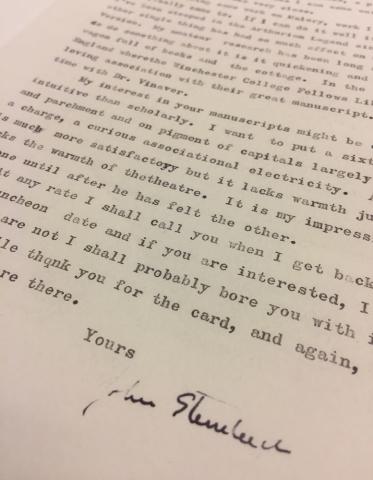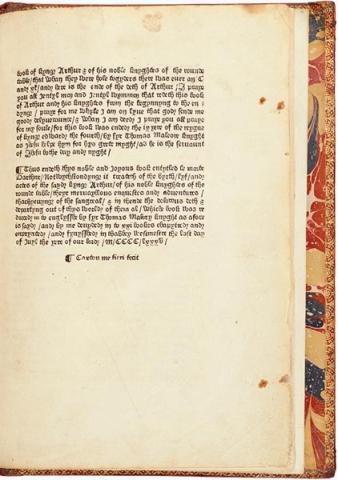 Sixty years ago today, John Steinbeck wrote this letter to Frederick Adams, the Director of the Pierpont Morgan Library. Steinbeck was an old friend of Adams and his letter, followed by the author’s subsequent visit to the Library, brought about a rekindling of their personal relationship and the beginning of Steinbeck’s scholarly and philanthropic relationship with the Morgan. This letter (MA 6432.1) conveys Steinbeck’s intellectual excitement at the prospect of closely examining the Library’s medieval manuscripts and books from the incunable period.
Sixty years ago today, John Steinbeck wrote this letter to Frederick Adams, the Director of the Pierpont Morgan Library. Steinbeck was an old friend of Adams and his letter, followed by the author’s subsequent visit to the Library, brought about a rekindling of their personal relationship and the beginning of Steinbeck’s scholarly and philanthropic relationship with the Morgan. This letter (MA 6432.1) conveys Steinbeck’s intellectual excitement at the prospect of closely examining the Library’s medieval manuscripts and books from the incunable period.
Steinbeck first came to the Morgan in winter 1957 to conduct research on Sir Thomas Malory, the author of Le Morte D’Arthur. The Morgan has the only surviving complete copy of the first edition, published by Caxton in 1485. He told Adams: “I’ve been steeped in the Arthurian Legend since I was ten years old. I guess no other single thing has had so much effect on my work except possibly the King James Version. . . . My interest in your manuscripts might be considered, I suppose more intuitive than scholarly. I want to put a sixty power glass on pen stroke and parchment and on pigment of capitals largely because the thing itself carries a charge, a curious associational electricity. Actually for study, microfilm is much more satisfactory but it lacks warmth just as motion picture film lacks the warmth of the theatre. It is my impression that one cannot understand the one until after he has felt the other.”
One of the medieval manuscripts that Steinbeck read in the winter of 1957 was Le Roman de Lancelot du Lac, circa 1310-1315, illuminated by the Master of the Life of St. Benedicta of Origny and assistants (MS M.805.) This is one of the finest and most important renditions of the Lancelot legend and the exploits of other knights of the Round Table. Lancelot, arguably the best known of the Round Table knights, became popular after Chrétien de Troyes (fl. 1170) transformed him into the chivalric lover of Arthur’s queen, Guinevere. Following his visit, Steinbeck wrote that when looking at this manuscript under high magnification he had discovered a “perfectly preserved” crab louse “embedded deep in the ink” on one of its pages. (I must confess that when I looked at this with my fellow curator, Bill Voelkle, formerly head of the department of Medieval and Renaissance Manuscripts, we couldn’t find Steinbeck’s louse!)
 Steinbeck described working on Malory as “a thing of great joy to me, like coming home.” In the years that followed, he generously donated a selection of his manuscripts to the Morgan. Among these was the journal he kept while writing his most famous novel The Grapes of Wrath, as well as his journals from the early 1950s. Steinbeck also donated the typescript for his 1961 novel The Winter of Our Discontent and, the year before his death, he gave the Library over one-hundred letters that he had published as a weekly column in Newsday from December 1966 through May 1967 (MA 2519.1-44 and MA 2581.1-63.) These letters, written during Steinbeck’s travels as a war correspondent in Vietnam, are addressed to “Dear Alicia.” (Alicia Patterson Guggenheim was the editor and publisher of Newsday from 1940 until her death in 1963, and Steinbeck addressed his letters “not . . . to someone who is dead, but rather to a living mind and a huge curiosity.”)
Steinbeck described working on Malory as “a thing of great joy to me, like coming home.” In the years that followed, he generously donated a selection of his manuscripts to the Morgan. Among these was the journal he kept while writing his most famous novel The Grapes of Wrath, as well as his journals from the early 1950s. Steinbeck also donated the typescript for his 1961 novel The Winter of Our Discontent and, the year before his death, he gave the Library over one-hundred letters that he had published as a weekly column in Newsday from December 1966 through May 1967 (MA 2519.1-44 and MA 2581.1-63.) These letters, written during Steinbeck’s travels as a war correspondent in Vietnam, are addressed to “Dear Alicia.” (Alicia Patterson Guggenheim was the editor and publisher of Newsday from 1940 until her death in 1963, and Steinbeck addressed his letters “not . . . to someone who is dead, but rather to a living mind and a huge curiosity.”)
Over the years, the Morgan has continued to add to its collection of Steinbeck manuscripts and letters. In 1994, the Morgan acquired the manuscript drafts of Steinbeck’s posthumously published work The Acts of King Arthur and His Noble Knights (MA 4949.) I think that Steinbeck would have been pleased that the manuscript of his modern retelling of the Arthurian legends is housed in the same collection as the illuminated manuscripts and books he consulted when he first set out on his research in 1957—that truly is “like coming home.”
Sir Thomas Malory (fl. 1470), Thys noble and joyous book entitled le morte Darthur…, Westminster: William Caxton, 31 July 1485, Purchased by Pierpont Morgan, 1911 PML 17560, ChL 1782.
